Input interpretation

1, 3-propylene glycol
Chemical names and formulas
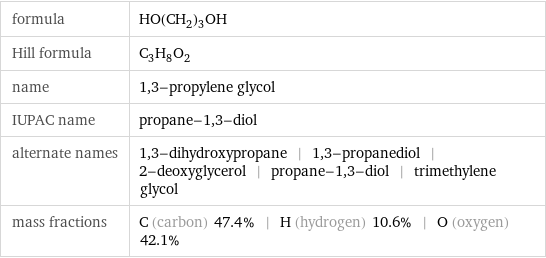
formula | HO(CH_2)_3OH Hill formula | C_3H_8O_2 name | 1, 3-propylene glycol IUPAC name | propane-1, 3-diol alternate names | 1, 3-dihydroxypropane | 1, 3-propanediol | 2-deoxyglycerol | propane-1, 3-diol | trimethylene glycol mass fractions | C (carbon) 47.4% | H (hydrogen) 10.6% | O (oxygen) 42.1%
Lewis structure
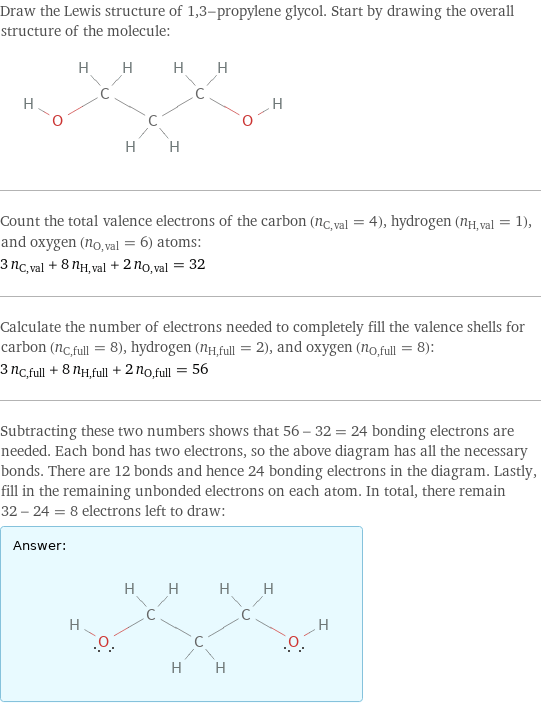
Draw the Lewis structure of 1, 3-propylene glycol. Start by drawing the overall structure of the molecule: Count the total valence electrons of the carbon (n_C, val = 4), hydrogen (n_H, val = 1), and oxygen (n_O, val = 6) atoms: 3 n_C, val + 8 n_H, val + 2 n_O, val = 32 Calculate the number of electrons needed to completely fill the valence shells for carbon (n_C, full = 8), hydrogen (n_H, full = 2), and oxygen (n_O, full = 8): 3 n_C, full + 8 n_H, full + 2 n_O, full = 56 Subtracting these two numbers shows that 56 - 32 = 24 bonding electrons are needed. Each bond has two electrons, so the above diagram has all the necessary bonds. There are 12 bonds and hence 24 bonding electrons in the diagram. Lastly, fill in the remaining unbonded electrons on each atom. In total, there remain 32 - 24 = 8 electrons left to draw: Answer: | |
3D structure
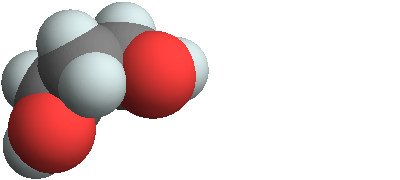
3D structure
Basic properties

molar mass | 76.09 g/mol phase | liquid (at STP) melting point | -27 °C boiling point | 214 °C (measured at 101308 Pa) density | 1.053 g/cm^3 solubility in water | soluble dielectric constant | 35
Hydrophobicity and permeability properties

predicted LogP hydrophobicity | -1.17 predicted LogS | 1.05
Basic drug properties

approval status | experimental | small molecule
Liquid properties (at STP)
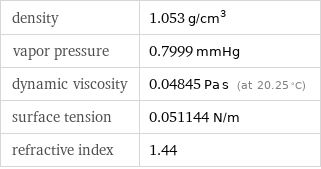
density | 1.053 g/cm^3 vapor pressure | 0.7999 mmHg dynamic viscosity | 0.04845 Pa s (at 20.25 °C) surface tension | 0.051144 N/m refractive index | 1.44
Units

Thermodynamic properties
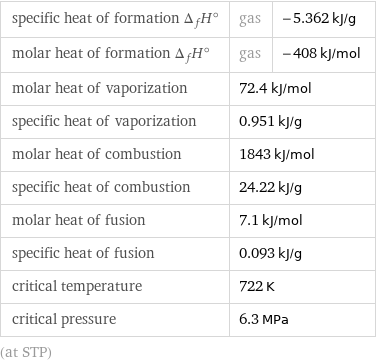
specific heat of formation Δ_fH° | gas | -5.362 kJ/g molar heat of formation Δ_fH° | gas | -408 kJ/mol molar heat of vaporization | 72.4 kJ/mol | specific heat of vaporization | 0.951 kJ/g | molar heat of combustion | 1843 kJ/mol | specific heat of combustion | 24.22 kJ/g | molar heat of fusion | 7.1 kJ/mol | specific heat of fusion | 0.093 kJ/g | critical temperature | 722 K | critical pressure | 6.3 MPa | (at STP)
Chemical identifiers

CAS number | 504-63-2 Beilstein number | 969155 PubChem CID number | 10442 PubChem SID number | 24877990 SMILES identifier | C(CO)CO InChI identifier | InChI=1/C3H8O2/c4-2-1-3-5/h4-5H, 1-3H2 InChI key | YPFDHNVEDLHUCE-UHFFFAOYAS RTECS number | TY2010000 MDL number | MFCD00002949
Safety properties
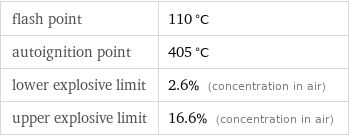
flash point | 110 °C autoignition point | 405 °C lower explosive limit | 2.6% (concentration in air) upper explosive limit | 16.6% (concentration in air)
Toxicity properties

odor | odorless

RTECS classes | mutagen